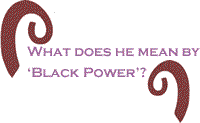|
On
the morning of November 15, 1998 it was learned that Kwamé
Turé (a.k.a. Stokely Carmichael) had made his transition
into eternity (died) in Conakry, Guinea.

Along
with Henry English of the Black United Fund of Illinois
(the administrator of the Kwame Ture Medical Fund), Saraduzayi
Sevanhu of the All African Peoples Revolutionary Party (A-APRP),
we were fortunate and honored to attend the memorial tribute
and burial of Brother Kwame on November 22nd in Conakry,
Guinea where Kwame had lived, worked, studied, taught, and
struggled the past thirty years.
On
the anniversary of his transition, we must remember Brother
Kwame’s contributions to the worldwide African Liberation
Movement.
In
the late 1960s, Brother Kwame Ture was one of the chief
spokespersons and organizers for the All African Peoples
Revolutionary Party (A-APRP), where he had lived in the
Republic of Guinea
in West Africa. While in Guinea,
Brother Kwame studied with, and worked under the guidance
of, the late President of Guinea, Ahmed Sekou Ture and the
late President of Ghana, Osagyefo Kwame Nkrumah.
Most
people throughout the world began to hear of Kwame (a.k.a.
Stokely Carmichael) during the Civil Rights Movement of
the 1960s where he participated in the first Freedom Rides
and many sit-ins and marches.
The
origin of Kwame’s participation in the Civil Rights Movement
began during his high school years at Bronx High School
of Science where he graduated in 1960. Kwame always had
a tendency to be active around the movement circles in New
York while in high school and this continued when he enrolled
at Howard University
in 1960.
 Primary
source documents reveal that, “In the Winter of 1960, Black
college students in dozens of communities across this country
conducted sit-ins to secure the desegregation of lunch counters
in drug and variety stores.” These sources go on to explain
that, “Arrests numbered in the thousands. On every major
college campus in this country, students organized groups
such as NAG (The Non Violent Action Group) at Howard
University to continue the Sit-In
Movement.” Kwame was a founding member of NAG and was one
of its early leaders. Primary
source documents reveal that, “In the Winter of 1960, Black
college students in dozens of communities across this country
conducted sit-ins to secure the desegregation of lunch counters
in drug and variety stores.” These sources go on to explain
that, “Arrests numbered in the thousands. On every major
college campus in this country, students organized groups
such as NAG (The Non Violent Action Group) at Howard
University to continue the Sit-In
Movement.” Kwame was a founding member of NAG and was one
of its early leaders.
Out
of this student activism, the Student Non-Violent Coordinating
Committee (SNCC) was formed at Shaw University in
April 1960. SNCC and its student base provided ground troops
for almost every major Civil Rights Demonstrations and Campaign
during the 1960s period of the Movement. Kwame was one of
the three hundred “Freedom Riders” that were arrested “in
Mississippi and Alabama
during the Spring and Summer of 1961.” From that point on,
Kwame participated in every major campaign that emerged.
Kwame
came to the public’s attention on November 16, 1965 when
Look Magazine featured an article titled, “Freedom
Road,” that mentioned Kwame’s role as an organizer and leader
of SNCC.
Several
months later, in June of 1966, Ebony Magazine historian
and writer, Lerone Bennett, Jr. wrote an article featuring
Kwame. Brother Bennett observed in this article that (a.k.a.
Carmichael) Kwame, like “No other young
man, with the exception of Martin Luther King, Jr. has risen
so fast so quick. No other young man has sparked such an
avalanche of hope, fear, anger, and public concern.” Bennett
asked the question, “Who is this young man? What does he
want? What does he mean by ‘Black Power’?”

Again,
primary source documents explain that, “In April, 1966,
at the Kingston Spring SNCC staff meeting (a.k.a. Stokely)
was elected chairman, ushering in a new level and direction
for both the organization and the larger movement of which
it was an integral part.” These same sources indicated that,
“In June, after James Meredith was gunned down on a highway
in Mississippi, (a.k.a. Stokely) sounded the new Black
mood.” This is what Kwame said: “The only way we are gonna
stop them white men from whippin’ us is to take over. We
been saying freedom for six years and we ain’t got nothing.
What we gonna start saying now is BLACK POWER!!”
Kwame was one of the leading advocates of Pan-Africanism
through his leadership in the A-APRP. Since the late 1960s,
Kwame has traveled throughout the world lecturing and organizing
African people to understand the need to struggle around
the idea of Pan-Africanism, “as the only solution to our
problems.”
 When
people in our movement give unselfishly, and consistently,
over the years, like Kwame, we must never forget them! When
people in our movement give unselfishly, and consistently,
over the years, like Kwame, we must never forget them!
BlackCommentator.com
Columnist, Conrad W. Worrill, PhD, is the
National Chairman Emeritus of the National Black United
Front (NBUF).
Click here
to contact Dr. Worrill.
|

